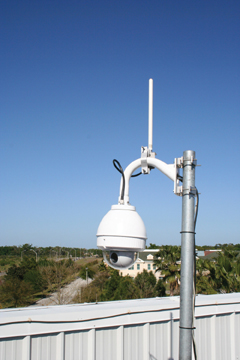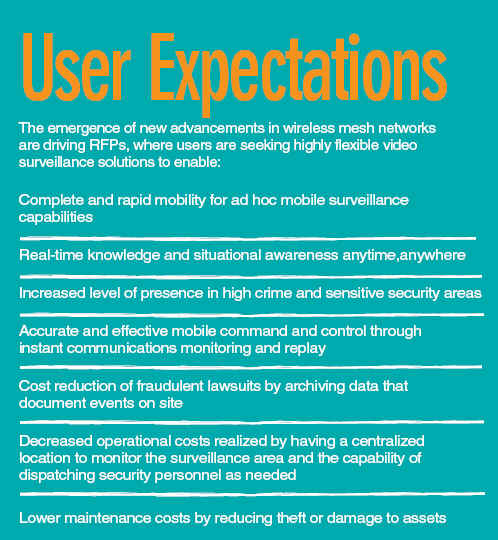Wireless broadband technologies are moving video surveillance into new arenas with the ability to transfer live video in real time to back-office and remote personnel via high-speed, secure wireless connections. By utilizing a mesh network to transmit video, large files can be sent instantly and the angle of the video can be controlled through pan, tilt and zoom features. These capabilities deliver unprecedented situational awareness to public safety personnel to protect and serve communities and assets.
By Tim Mason
High speed, high bandwidth applications are the main drivers of wireless broadband networks today. Video surveillance is emerging as one of the most compelling, due to its ability to address the security concerns of many constituents including government and public safety agencies, residents, tourists and businesses. No longer is video surveillance seen as a tool of ‘big brother’ but rather as a reality of life, a ‘force multiplier’ that provides an additional sense of security in uncertain times.
According to an OnWorld report, Muni Wireless Broadband: Service Oriented Mesh Ups, July 2007, “Already widespread in Europe and Asia, video surveillance is currently a growing trend in the U.S. New digital technologies and wireless broadband integration are driving the network camera market that is predicated to reach US$1 billion in 2009.”
Deploying the right kind of wireless broadband network, one that supports real-time, streaming, high bandwidth video is essential to enabling wireless video surveillance. Mesh networks for video surveillance can help improve operational efficiencies, increase public safety and ultimately, reduce the cost of ownership.
PANNING THE INDUSTRY
|

|
|
Mesh camera installed (Photo by Motorola) |
Video surveillance is synonymous with one fundamental concept: security. Video intelligence has made its way into varying arenas in order to enhance security. In public safety, deployments are increasing in high crime areas, in public transportation, at borders and in ports. In addition, video surveillance is also increasing in the enterprise market for ground and asset monitoring and in campus environments.
A typical public safety video surveillance deployment consists primarily of a single or multi-camera installation in high crime areas or trouble zones. Real-time monitoring of video by security or public safety personnel is proving to be a real deterrent to crime.
In the Jordan Downs public housing complex in Los Angeles, California, the U.S.A., a Motorola mesh network for wireless video surveillance became operational in 2007. The wireless network is part of a project designed to help curb criminal activity and provide a safe environment for residents in one of the city’s most notorious high-crime public housing areas. Since the cameras were installed major crime has dropped 32 percent compared to the same period the previous year. Jordan Downs is just one example of how video solutions are increasing community safety. Additionally, some airports and seaports across America are building systems using video intelligence given the emergence of more stringent homeland security policies.
As the industry moves forward, customers will increasingly look to deploy integrated solutions that include sensors, analytics and mobility over a standards-based wireless broadband network, thus allowing users to transmit large video streams in real time. The emergence of new advancements in wireless mesh networks are driving RFPs, where users are seeking highly flexible video surveillance solutions to enable:
-
Complete and rapid mobility for ad hoc mobile surveillance capabilities
-
Real-time knowledge and situational awareness anytime, anywhere
-
Increased level of presence in high crime and sensitive security areas
-
Accurate and effective mobile command and control through instant communications monitoring and replay
-
Cost reduction of fraudulent lawsuits by archiving data that document events on site
-
Decreased operational costs realized by having a centralized location to monitor the surveillance area and the capability of dispatching security personnel as needed
-
Lower maintenance costs by reducing theft or damage to assets
Security and public safety agencies understand the importance of intelligent, standards-based video that improves operational efficiency and security while ultimately reducing the cost of deployment and network maintenance. For example, airports and seaports are looking for applications that define normal activity for a given space or coverage area, whether it’s an exterior perimeter fence, interior directional flow and queuing, or vehicle tracking. This requires the seamless integration of video, sensors, networks and even voice. Video storage is also an important capability for use in court trials for evidentiary purposes or other post-mortem activities. These solutions can range from small-scale deployments such as a networked digital video recorder to a Storage Area Network (SAN) for a larger-scale, citywide video systems.
The network transport or infrastructure currently deployed to support surveillance varies by industry. The private enterprise sector, which primarily focuses on facility and asset surveillance, sometimes uses the 802.11 standard for a wireless-based infrastructure. In other cases, enterprises will utilize a typical wired-based solution consisting of standard coaxial-based cable system or even Ethernet for an IP-based camera system. Until recently, the public safety industry has predominantly deployed systems using the 802.11 standard in the 2.4GHz spectrum. Now with the allocation of the 4.9GHz spectrum for licensed first responder communications, public safety agencies are seeking wireless broadband surveillance solutions that leverage this licensed spectrum in order to migrate away from the crowded 2.4GHz band.
The allocation of the 4.9GHz spectrum and the advent of wireless mesh networking technology allow city agencies and enterprises to outfit security personnel with remote handheld devices for maximum mobility, removing the constraints associated with the fixed-viewing locators dictated by wired infrastructure. Mobility is a major requirement that is pushing creative surveillance solutions to look beyond just the video camera. New systems must provide seamless integration with video applications, the network infrastructure, back office storage systems and mobile devices.

CURRENT STATE OF SURVEILLANCE
An industry report by Gartner, What Type of Video Surveillance is Right for your Organization, states, “As video surveillance becomes more prevalent, organizations will come under increased pressure to quickly deploy video surveillance, and the likelihood that it will be done inappropriately will increase.” The one-size-fits-all approach to video solutions is doomed to fail. It’s important for organizations to evaluate their current and future needs and build a system that will meet their requirements. Working with a vendor experienced in wireless video surveillance and outdoor wireless broadband networking who can also serve as a consultant and advisor is the key to building the right system.
Many public safety and government agencies are deploying integrated video surveillance solutions that leverage an open, standards-based architecture and deliver a complete unified communications concept (voice, video, and data). This open framework can be adapted to work with existing systems and provide interoperability with legacy IT environments. The goal is both to create scalability and to leverage the existing network infrastructure. In many cases, this model incorporates a centralized content storage system that provides high speed, simultaneous search and access of aggregated video content. If executed properly, this solution offers an interoperable visual communications backbone for intelligent, cost-effective video network security.
FAST FORWARD TO THE FUTURE
With the growing popularity of video surveillance networks, vendors and network operators are beginning to leverage existing and newly deployed mesh networks to enhance and expand the capabilities of their assets. Mesh-enabling a video surveillance camera turns every camera on the network into a router/repeater, enhancing the strength of the network and extending coverage by creating more data paths.
As an example of the convergence of wireless mesh technology and IP video, Motorola offers a mesh camera wireless video networking system -- in which the video camera, the Sony IPELA SNC-RX550N/W-MT and SNC-RX550N/B-MT, combines wireless video support and mesh routing functionality into a single system. These mesh-enabled cameras provide a cost-effective way of adding live video surveillance to mesh networks, while extending wireless coverage in a single step and negating the need for additional deployment time and expenses associated with other solutions that require separate video pods and mesh access points.
The integrated design and instant scalability of the mesh camera wireless video system also provides an ideal solution for quick, temporary deployments such as sporting events, county fairs, or at an incident scene. When mesh cameras are deployed they instantly join the existing mesh network or form a network among themselves. In the case of an incident scene where a mesh network might not be present, incident commanders can set up an ad hoc video network on-scene to improve situational awareness. These video systems are easily removed and can be used again at the next incident.
Additionally, the cameras feature a 360-degree “endless” pan and can tilt from 0 to 90 degrees. The full-range pointing capabilities can be masked to create privacy zones with spherical (three-dimensional) tracing, and its high quality lens has a 26X optical zoom. Personnel can remotely control pan, tilt and zoom options, giving total control of the field of view.
TACKLING SECURITY
The Super Bowl, the championship game of the National Football League (NFL) in the United States, draws an enormous crowd every year and 2007 was no different with attendance at approximately 74,000. While all eyes were on the game during Super Bowl XLI, the Miami-Dade police department secured Dolphin Stadium by using a Motorola mesh network wireless video surveillance system for increased situational awareness.
Motorola and video security solution provider, NICE Systems, deployed a temporary surveillance system, which allowed wireless mesh cameras to be strategically operated from numerous vantage points throughout the stadium in order to increase the safety of such a large crowd.
Public safety officers and agents from state and federal law enforcement agencies were able to monitor real-time video surveillance and access mission critical applications such as criminal databases, over a MOTOMESHTM Quattro network.
Currently, video surveillance technology brings valuable functionality to security personnel. The ability to wirelessly control video surveillance with a handheld device, pan through a crowd and even zoom in on suspicious activity is a strong testament to the power wireless video puts in the hands of those who protect the public.
Integrated wireless video surveillance systems provide cost-effective, robust and easy-to-deploy solutions for a wide range of fixed and mobile video monitoring applications. Users can now manage and monitor larger geographical areas more effectively and economically. In addition, mesh networking enables mobile access to wide area video and instant ad hoc video network capabilities at an incident scene.
As mobility solutions like mesh networking evolve, video surveillance will continue to benefit. Clearly the use of video surveillance will continue to expand to ensure the protection of communities, security personnel and assets worldwide.
Tim Mason is Director of MOTOwi4 Wireless Broadband Solutions Marketing for Motorola (www.motorola.com).
For more information, please send your e-mails to swm@infothe.com.
ⓒ2007 www.SecurityWorldMag.com. All rights reserved.
|


